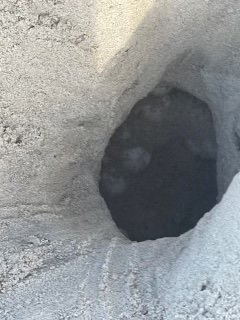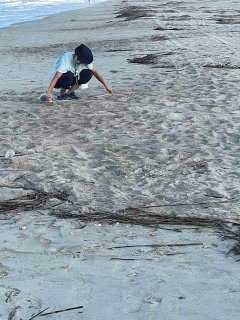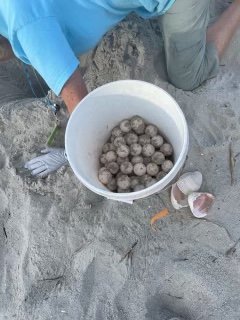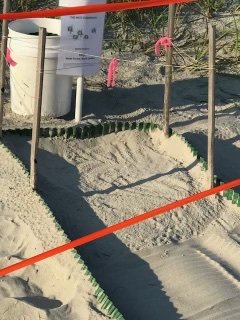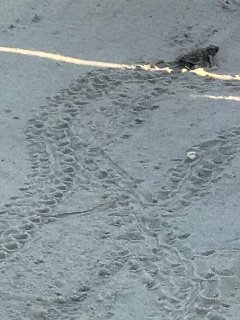The Nesting of Loggerhead Turtles Here in North Carolina
The North Carolina coastline is blessed to have Loggerhead turtles come to nest on its beaches. The Loggerheads are considered an endangered species of wildlife and are at risk of extinction if measures are not taken to ensure their sustainability.
Fortunately, those along the coastline have formed patrols in areas where many turtles come to shore to nest.
Turtle Patrol
While most sightings of nests and turtles are along the southern beaches; most recently they have even been found on the outer banks, which hasn’t occurred in over 25 years!
2024 is turning into another active year for sea turtles on the Cape Hatteras National Seashore
With all the protective measures in place for the turtles, local fishermen are seeing more turtles in the waters while fishing. And because of being on the endangered list, fishermen are releasing turtles that end up caught in their nets to avoid prosecution.
Did you know that these turtles come to nest on the same shores where they were hatched? When females come to shore to nest, they may lay 50-110 eggs at a time.
Turtle Eggs Located In A Nest
She may come to shore multiple times during egg laying season (May-August) and may have multiple breeding partners for the breeding. Each time she comes ashore under the cover of darkness, slowly crawling ashore to find what she thinks is the perfect nesting site. Then she digs a hole up to two feet deep with her feet and flippers. The nest is deep so that the eggs will be placed in moist sand to keep them at the right temperature. The task is daunting and can take multiple hours, as these large turtles are very awkward on land. Once she has laid her clutch, she then covers it up and returns to the ocean. To the unsuspecting eye, you would only notice some disturbed sand and would consider it from people on the beaches during the day.
But her tracks tell a different story…
Turtle Tracks
Not only can these tracks tell patrols where to look for disturbed sand, (possibly indicating a nest); but the width of the flipper tracks can give an indication as to the possible size of the female.
Measuring Turtle Tracks
Then if a suspected “disturbed” area of sand is found, the patrol digs out the area carefully to specifically locate the nest.
Patrol Digging Out The Nest
If a nest is located, the patrol decides whether the nest is in a safe region (away from the tidal zone), or whether the nest should be relocated to a safer place.
With each nest location, the patrol takes an egg and submits it for DNA analysis. It has often been found that grandmothers, mothers, and daughters have all laid eggs at the same beaches!
If it is determined that the nest should be moved, then the patrol carefully completely digs out the nest and places the eggs in a bucket as close to the way they were arranged in the original nest.
The eggs are soft and about the size of a ping-pong ball. The patrol then relocates the nest to a safer place, digs a hole, and places the counted eggs in the nest. Afterward, a rope is placed around the nest to number the nest for incubation and to locate and protect it
Roped Off Turtle Nest
All turtle nests are logged and numbered to know the approximate incubation period of the clutch.
So how long is the incubation period? That is determined by the temperature. The normal range is around 49-63 days but varies with the temperature. Warmer temperatures of the sand accelerate development of the eggs, while cooler temperatures slow development. Female eggs prefer warmer temperatures, while males prefer cooler temperatures.
As the time nears for maturity of the eggs to hatch, the patrol places a “runway” down from the nest to the surf so as to help guide the hatchlings on their journey to the sea.
Turtle Runway
So, what does the patrol look for at the nest during this time? Usually, a small grate is placed over the nest, and it is swept so as to note any indentions in the sand. This could indicate that hatching and movement is beginning to occur beneath the surface.
When the sand begins to cave in, the hatchlings are trying to get to the surface. This is called the “boil” (their birthday). Remember, some have to climb up out of a two foot hole to the surface! Hatchlings are about 1.8” long and it takes a lot of determination to break out of the egg and climb to the surface.
Hatchling Makes It’s Way
Most boils occur under the cover of darkness, when it is not only cooler, but to avoid the sea gulls and ghost crabs, dogs, fish, dehydration etc. The hatchlings vision is poor at night, and they become disoriented by light and tend to move in the opposite direction.
Once the nest boils patrollers revisit the nest at 3 days and carefully dig out the remains of the nest only to find some eggs that never hatched and several stragglers that are so deep in the nest that they need assistance to the surface.
This is often a very exciting time for visitors to watch and experience this miracle. Often crowds will come around 7-7:30 to witness the event and to see the hatchlings. Visitors are asked to be very quiet as the spectacle begins and the narrator tells the story.
Witnessing This Amazing Event
Patrollers often assist hatchlings if they start moving the wrong way as they begin their perilous life’s journey.
Swimming Out To Sea
Did you know that only one in 1000-10,000 hatchlings are estimated to make it to adulthood?! Once the hatchlings reach the water, they are swept away by the tide and begin swimming to the Sargasso Sea, some 100 miles offshore, while dodging predators along the way. Once there they feed on algae and plankton and remain there for many years. Not much is known about them and their development during this time.
Loggerheads reach maturity at approximately 35 years and can live up to 75-80 years. At sexual maturity, the females start coming ashore and laying their clutches only to renew the cycle of life every two to three years.
Should you ever get the chance to witness this event, it will be something that you will remember forever!
Blog written by—Teresa Klatt, DVM




